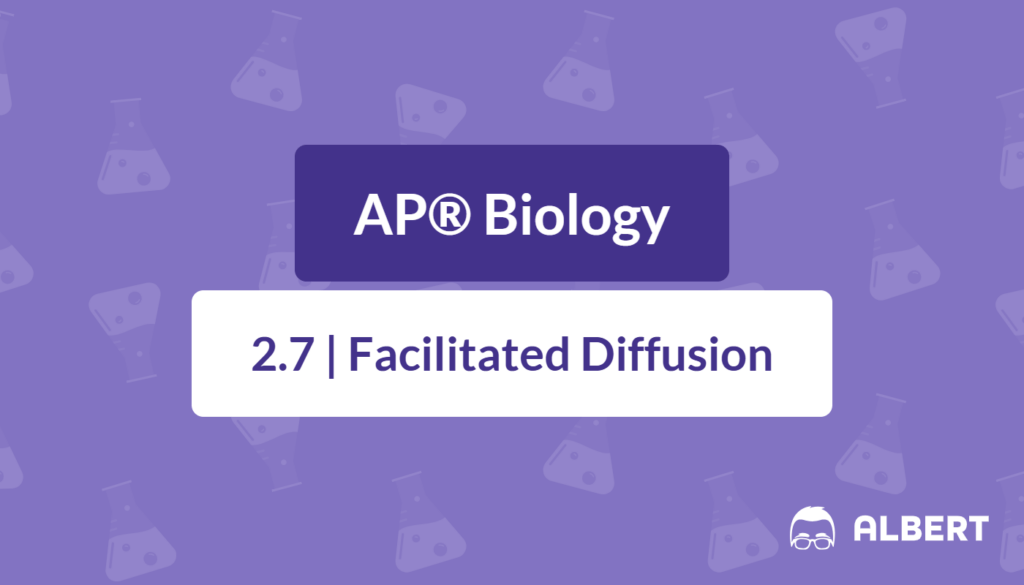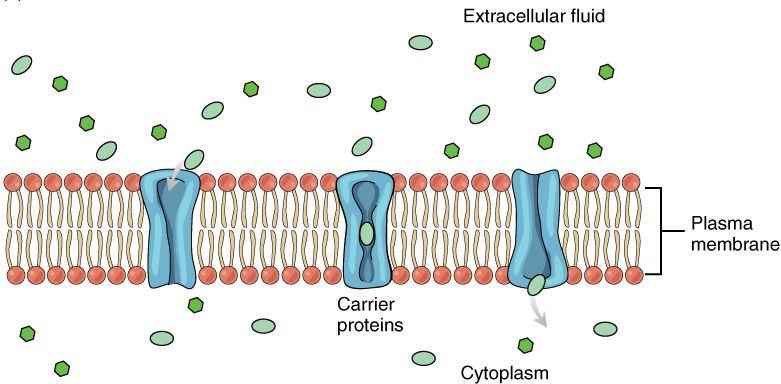What We Review
Introduction
Transport mechanisms are vital for all living cells, as they help regulate the uninterrupted flow of molecules into and out of the cell. One key process you’ll encounter in AP® Biology is facilitated diffusion—a passive transport mechanism that relies on membrane proteins to move substances across the plasma membrane. In this post, we’ll walk through the structure of the membrane, define facilitated diffusion, highlight key players like channel proteins and carrier proteins, and compare this passive transport method with active transport.
Understanding the Plasma Membrane
A. Structure of the Plasma Membrane
The plasma membrane is composed primarily of a phospholipid bilayer with embedded proteins. This unique structure creates a selectively permeable barrier, allowing certain molecules to pass freely while restricting others. Each phospholipid contains a hydrophilic head and two hydrophobic tails, forming a bilayer that separates the cell’s internal environment from the outside.
B. Factors Affecting Molecule Passage
Whether a molecule can cross this membrane depends on its size, polarity, and charge. Small, nonpolar molecules (e.g., carbon dioxide) can generally move readily through the lipid bilayer. Conversely, large or charged molecules (such as ions) need specific transport strategies like facilitated diffusion or active transport to get them where they need to go.
What Is Facilitated Diffusion?
A. Definition
Facilitated diffusion is a type of passive transport. As the term “passive” implies, it does not require any direct energy input from the cell (no ATP needed). Instead, molecules move down their concentration gradient—from an area of higher concentration to an area of lower concentration—through specialized membrane proteins.
B. Comparing Passive and Active Transport
In contrast to facilitated diffusion, active transport requires an input of ATP to move molecules against their concentration gradient (from lower to higher concentration). Examples of molecules moved via active transport include ions like \text{Na⁺} and \text{K⁺}, especially when they are pumped in or out of the cell by protein pumps (such as the \text {Na⁺/K⁺ ATPase}). Meanwhile, facilitated diffusion only helps substances flow in the direction they were already inclined to move.
Role of Membrane Proteins in Facilitated Diffusion
A. Types of Membrane Proteins
- Channel Proteins: These form pores or tunnels across the membrane, allowing specific ions or molecules (such as \text{Na⁺} or \text{K⁺}) to flow through. Ion channels are often gated, meaning they can open or close in response to signals like voltage changes.
- Carrier Proteins: Instead of forming a continuous channel, carrier proteins bind to larger molecules (e.g., glucose) on one side of the membrane and change shape to shuttle them across. This process does not require ATP, since these molecules move down their concentration gradient.
B. Specific Molecules Transported via Facilitated Diffusion
Two well-known examples are water and ions. Water molecules pass through specialized channel proteins called aquaporins, which greatly increase the rate at which water enters or leaves a cell. Charged ions like \text{Na⁺}, \text{K⁺}, \text{Cl⁻}, and \text{Ca²⁺}, meanwhile, rely on ion channels or carriers to navigate the hydrophobic interior of the phospholipid bilayer.
The Process of Facilitated Diffusion
A. Mechanism Overview
Facilitated diffusion can be visualized as a revolving door for the cell. Substances fit into their respective channel or carrier protein, which then assists them in crossing the membrane—always from high to low concentration.
B. Dynamic Equilibrium
Once the concentrations on both sides of the membrane equalize, net movement stops. This does not mean the molecules stop moving altogether; rather, there is no overall net movement in one direction once equilibrium is reached.
Importance of Facilitated Diffusion in Cells
A. Biological Significance
Facilitated diffusion is critical for maintaining homeostasis. Cells rely on this mechanism to bring in nutrients, expel waste (if applicable), and maintain proper ion balances without depleting their ATP reserves.
B. Examples of Facilitation in Different Cell Types
- Red Blood Cells use facilitated diffusion to quickly move glucose across their membrane for energy production.
- Muscle Cells rely on facilitated diffusion to balance ion gradients, crucial for contraction and relaxation.
- Neurons regulate ion flux (especially \text{K⁺} and \text{Na⁺}) via channels to maintain membrane potential and facilitate nerve impulses.
Related Concepts in Membrane Transport
A. Active Transport Overview
Active transport uses ATP to push molecules against their concentration gradients. Protein pumps like the \text{Na⁺/K⁺ ATPase} are prime examples, maintaining ion gradients that are essential for processes like nerve signal transmission.
B. Polarization of Membranes
Ion movement across membranes contributes to electric potentials. For instance, the inside of a neuron’s plasma membrane is typically negatively charged relative to the outside. The distribution of ions, achieved through both facilitated diffusion and active transport, ensures the proper firing of nervous signals.
Practice Problems
- Identify the following scenarios as examples of facilitated diffusion or another mechanism (simple diffusion or active transport).
- Oxygen crossing the membrane without a protein.
- Glucose entering a cell through a carrier protein, moving down its concentration gradient.
- Sodium ions pumped out of the cell against their concentration gradient using ATP.
- Compare and Contrast Active and Passive Transport
- What role does ATP play in active transport, and why is it unnecessary in facilitated diffusion?
- How do channel proteins differ structurally and functionally from carrier proteins?
- Membrane Protein Function: Consider a situation in which a cell is placed in a high-glucose environment but has no functional carrier proteins for glucose.
- Predict and explain what will happen to glucose uptake.
- How would the use of protein pumps in active transport support or counteract the effects of facilitated diffusion in maintaining ion balance?
Conclusion
Facilitated diffusion exemplifies how cells harness the natural tendency of molecules to move down their concentration gradient, using specialized proteins to increase efficiency while sparing energy. By understanding how the plasma membrane’s structure, protein helpers, and concentration gradients work together, you gain a clearer view of how life’s most fundamental processes happen at the cellular level.
Keep these concepts in mind as you explore how cells maintain homeostasis, regulate their internal environments, and communicate with their surroundings. Understanding the interplay between active and passive transport lays a foundation for mastering cellular biology in AP® Biology and beyond.
Sharpen Your Skills for AP® Biology
Are you preparing for the AP® Biology test? We’ve got you covered! Try our review articles designed to help you confidently tackle real-world math problems. You’ll find everything you need to succeed, from quick tips to detailed strategies. Start exploring now!
Need help preparing for your AP® Biology exam?
Albert has hundreds of AP® Biology practice questions, free response, and full-length practice tests to try out.









